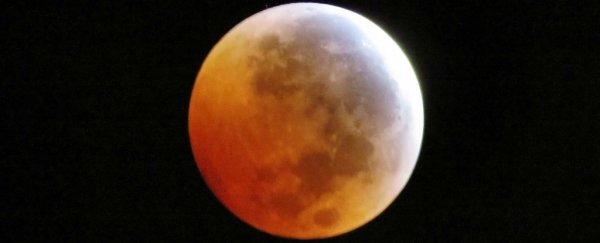On Sunday evening, September 27, you'll get the chance to see a rare type of lunar eclipse that hasn't happened since 1982. It is called a supermoon total lunar eclipse, and over the last 115 years there have only been five of them.
Total lunar eclipses are pretty rare - this Sunday's event will be the last one we see until 2018 - but a supermoon total lunar eclipse is significantly rarer because you have two events that already don't often happen taking place simultaneously: a supermoon and a total lunar eclipse.
Supermoon is the colloquial name for a Moon that is both full (or new) and at its closest approach to Earth - a term called perigee. Sunday night's supermoon will be just 356,877 km from Earth, which is a lot closer than its average distance of 384,472 km.
As a result, the Moon will appear about 13 percent larger than normal, reports Sky and Telescope. While that's not a giant difference, it will certainly make the total lunar eclipse a sight worth seeing. So don't miss it!
How and where to see it
The best place to see the event - which will begin at 9:07 pm ET on Sunday (1:07 am UTC and 11:07 am AEST on Monday) - will be on the east coast of the US because you can watch all five main stages of the eclipse.
If you're on the west coast, the Moon will rise a little later, which means you'll miss the first couple of stages.
But don't worry. The main event - when the Moon is completely shrouded in Earth's shadow - will still be visible. What's more, the Moon will remain in shadow, completely eclipsed from the Sun, for exactly 1 hour and 12 minutes.
And if your skies are too cloudy to see the Moon there are a number of live broadcasts of the event so you don't miss it, because the next one won't come around until 2033:
- NASA will begin a broadcast at 8:00 pm ET on Sunday (midnight UTC and 10:00 am AEST on Monday).
- Sky and Telescope's live webcast will start at 9:00 pm ET on Sunday (1:00 am UTC and 11:00 am AEST on Monday).
- And the online observatory, Slooh, will host a livestream view of the event at 8:00 pm ET on Sunday (midnight UTC and 10:00 am AEST on Monday).
During the time of total eclipse, the Sun's light doesn't reach the Moon directly but instead of turning black, the Moon will adopt a beautiful, deep, blood-red hue. So, if you look up on Sunday night and see a red moon, it's not the impending apocalypse but just astrophysics at work.
Check out the map below from TimeandDate.com to see which parts of the eclipse you can see depending on where you are in the world:

What you will see
A partial eclipse of the Moon will begin at 9:07 pm ET Sunday evening (1:07 am UTC or 11:07 am AEST Monday morning), which is when anyone looking into the night sky will begin to notice something odd is happening. During this first stage of the eclipse, the Moon will being to slowly disappear, growing into a ever-smaller crescent.
And by the time the total eclipse starts a couple of hours later, at precisely 10:11 pm ET (2:11 am UTC and 12:11 pm AEST) the Moon will reappear and start to adopt the iconic red hue. After the total eclipse ends at 11:23 pm ET (3:23 am UTC and 2:11 pm AEST), the Moon will turn back to its grey-white colour.
Again, the Moon will look like a crescent, but instead, this time the crescent will grow back to a full moon instead of shrinking into a blood moon. This image by Fred Espenak, with a detailed description of the eclipse on his website, shows what the different stages of a total lunar eclipse look like:

And here's a handy break down, by Sky and Telescope, of each of the five stages and what time they will take place (in ET):

Check out the live Slooh broadcast, starting at 8:00 pm ET on Sunday (midnight UTC and 10:00 am AEST on Monday) below:
This article was originally published by Business Insider.
More from Business Insider:
